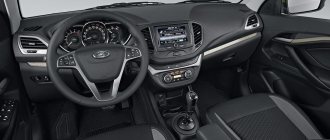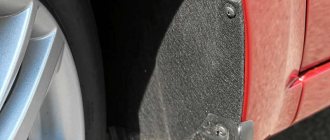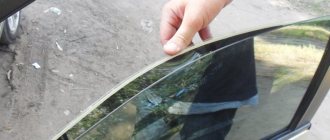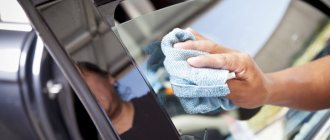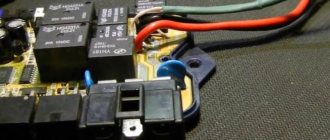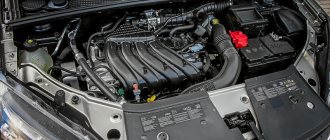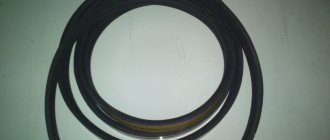A car is not only a means of transportation and an opportunity to be more independent; for men it is a second home, a status indicator. And in the house you want coziness, comfort, privacy. How to achieve this effect in a car? The only solution in this case is to tint the windows . But how can you do this so that traffic police officers don’t have any complaints against you, because no one wants to pay another fine? The solution is tinting, which the device does not see. And we will tell you what it is later.
We study the positive and negative aspects of tinting
Car rear window tinting
According to the traffic rules and legislation of our country, window tinting should not interfere with the movement of the car on the road and must comply with regulatory data, otherwise the traffic police officer has every right to impose a fine and forcibly demand the removal of the tinting film. To tint or not? How not to make a mistake? Let's look at the main positive and negative aspects of using various tint films . Vehicle owners include the following positive aspects of auto tinting:
- inability to study what is inside the cabin. This makes it easier to leave things inside the car without drawing unnecessary attention to them;
- increasing the comfort of movement. In addition, during a traffic stop, visibility of what is happening inside the car is limited;
- in the event of an accident, the film holds glass fragments, preventing them from flying inside the car, protecting passengers from injury; – the film protects the interior from solar influence, preventing it from fading and heating;
- the driver is protected from the sun's rays and, at night, from car headlights that distort the view of the road surface.
Negative sides:
- tinted windows significantly reduce visibility at night, parking takes longer;
- penalties for improper glass tinting;
- high cost of work and materials.
Article on the topic: How a tire pressure sensor works
Advantages and disadvantages of tinting
Let's start with whether it's worth tinting your car at all. The main advantages of this technique include:
- attractive appearance of the car;
- more comfortable stay in the cabin;
- prying eyes do not penetrate into the car;
- interior elements do not fade under the influence of the scorching sun.
There are, of course, negative aspects. The most important of them is the limitation of visibility and visibility, which the driver will inevitably have to face, because the film impairs transparency.
It is for this reason that traffic rules regulate what the light transmittance of a tinted surface should be. In some cases, you will have to tear off the coating, which means that the money on it was wasted.
Acceptable tinting
How do you know if your tint film falls within the rules and standards of the road rules? The main indicator that is checked by the traffic police inspector during a traffic stop is the light transmittance of the tint. When the film is properly glued, the darkening of the glass is almost invisible; it is glued in accordance with standard indicators and is not visible to the device for measuring the light transmittance of glass - a taumer. Please note that the permissible light transmittance rate for tinted windows is: windshield - at least 75%, side - front, at least 70%, rear - not installed. Mirror tinting is prohibited! Be sure to study this indicator before purchasing film; the indicators must be indicated on the packaging. If there is no such indicator, check with the seller. Tint films, which were often used by car enthusiasts, had standard indicators and varied in the range of 5, 15, 20, as well as 35 and 50%. The numerical index indicated the percentage of light transmission. Tinting with 100 percent light transmittance has only recently come to the market in our country, allowing it to be used without fear of negativity from the traffic police. There are several ways to tint windows:
- stick the film. The most common and inexpensive method;
- spraying method;
- electronic window tinting.
What does the market offer?
The main parameters by which light transmission capacity is assessed in 2022 are described in the relevant GOSTs. If we open them, we will see that the windshield must transmit at least 75% of the incoming light. For front side door windows, this figure is slightly more gentle and is at least 70%. When you purchase a tint film, you need to familiarize yourself with the criteria that the manufacturer indicates on the packaging. Better yet, ask the seller what the throughput of the glass will be after application.
One of the most popular is the new film from the American company Solar Gard. There is ongoing discussion on numerous automotive forums about whether it really guarantees that the device will show 100% light transmission? This manufacturer has long been known in the field of creating special coating materials that are used not only in the automotive industry, but also in architecture. On the other hand, the company itself does not guarantee that the device will not notice the tint completely.
Miracle - film from the USA
One of the tints, which the device does not see, is produced by the company “Solar Gard” (USA). The company produces miracle tinting with 100% light transmittance. In addition to this indicator, the characteristics of solar gard tinting, which the device does not see, include heat and sound insulation, increased glass strength, and durability. The color (shade) of the glass does not change after gluing the film; solar gard tinting also does not interfere with visibility while driving and has a high degree of protection from ultraviolet radiation.
Characteristics of athermal film
Manufacturers of glass films produce their products with different characteristics, expressed in the percentage of darkness, which determines the light transmittance parameter. Athermal film provides 80-90% light transmittance. The nanoceramic coating of the thinnest graphic layer transmits the visible spectrum of light, blocking no more than 25% of the light flux, taking into account the resistance of the equipped glass. The products fully fulfill the functions assigned to them to ensure comfort, protection from hot sunlight and exposure to ultraviolet radiation, and also comply with the regulatory requirements of technological regulations. Vehicle windows equipped with athermal tinting:
- transmit over 75% of the light flux;
- block up to 99% of ultraviolet radiation and 55% of heat.
"Smart" tinting
Another type is electronic tinting SPD technology, which allows you to change the light transmittance of the glass within a few seconds and at the request of the driver, but not determined by the taumeter. Tinting can be carried out either by completely replacing the glass with three-layer smart glass, or by using film. This technology uses two types of film:
- liquid crystal, working on the principle of photoelectric effect. The main difference from the usual tint film is the connection of such tint to the car's power supply. Depending on whether current is applied, the film changes color from matte to transparent;
- electrochromic, working on a similar principle, but differing in the type of coating. In this case, the film is sensitive not only to the effects of current (force), but also to external factors (temperature, lighting).
Article on the topic: Reasons for increased fuel consumption in cars
Installing electrical tinting on a car
Electronic tinting is supplied to the automotive market in the form of smart glass. Smart glass is connected to a control device, which will change the degree of light transmittance of the car windows. Changes can be made smoothly and step by step. The control panel is located near the driver. If there is a need to improve visibility, it sets the light transmittance to 100% and darkens the glass to the desired level to protect against blinding rays of the sun.
Accordingly, when meeting with a traffic police officer, transparency changes in a split second and is set within the limits permitted by law. The wiring is hidden in the car body, which prevents it from being damaged during operation. Electro-tinting becomes completely opaque when the power is turned off, which does not allow curious passers-by or malicious purse snatchers to look into the car.
Electrotinting is low maintenance, since the film and electronic filling are securely enclosed in glass, and the edges are sealed with sealant. The car will easily withstand any wash. The battery energy required is insignificant - 7 W per square meter of glass.
The technology for producing electric tinting is innovative, so the cost is very high, however, Russians are already using smart glass. The pace and prospects for the development of the production of this type of glass tinting indicate that a change in cost can be expected in the near future, and it will become available to owners of middle-class cars.
Video “Unexpected results of tinting measurement”
In this video you can watch the reaction of traffic police inspectors who cannot understand why a car with tinting has 99% light transmittance.
Pros and cons of this tint
Anyone who has come across such a unique offer already knows the advantages of “invisible” tinting for devices. With its help you can tint your windows 100%. At the same time, the meter at the stationary traffic police post will show the absolute transparency of the windows, which, in principle, excludes any claims from traffic police officers.
The advantages of dense tinting are known to everyone: first of all, it is protection from the sun's rays hitting the eyes, as well as the upholstery from fading. It follows that tinting helps to significantly reduce the use of air conditioning, which means saving fuel and preserving appliances.
Not to mention the fact that the darkening reliably hides everyone in the cabin from prying eyes of observers.
In addition, any film, even the thinnest one, gives the glass additional strength and, in the event of damage to the window, holds the fragments together, preventing them from falling into the interior.
But in addition to the positive ones, one should also take into account the negative aspects of this mythical film. After all, even if you manage to avoid a fine and deceive the measuring device, the inconvenience of overly tinted windows will not go away:
- Dark windows make parking very difficult, especially at night and in the evening.
- The driver also has difficulty viewing the surrounding area and seeing space in the rearview mirrors.
- In addition, the price of tinting such as Gard Solar, as a rule, is many times higher than the cost of an ordinary film, which can cover several dozen hypothetical fines at once. The reason is the complex technology and installation of this type of tinting. The product itself is called “electrochromic tinting” and the essence of its work is that as long as no voltage is applied to the glass, it remains dark. But as soon as the measuring device is brought to the surface and voltage is applied, the place of contact becomes transparent.
- In the end, a traffic police officer can issue a fine based on a simple visual inspection of the glass without using a device, which completely kills the point of purchasing this type of film, because glass with low light transmittance can be easily identified by eye.
As a result of familiarizing yourself with all the above-mentioned disadvantages of “invisible” tinting, any sane car owner has a logical question - does my car really need tinted windows?
Is it worth buying?
Even if you are ready to pay a certain amount for such tinting, there is always a certain risk. First of all, there is the possibility of running into a fake when purchasing. Today, Internet sites and forums are simply filled with scammers who take money for “invisible” film.
As a result, in the best case, you receive the most ordinary tint by mail, in the worst case, you receive nothing. It is quite difficult to distinguish fake manufacturers from real ones, but it is possible.
To begin with, loud numbers should alert you - sellers promise 100% transmittance, but experts say that such readings cannot be achieved even from completely transparent glass.
In addition, many manufacturers are ready to send a paid sample of film “for testing” and if you receive such an offer, this is a sure guarantee that your money will be wasted.
And even if you manage to get hold of this expensive miracle film, successfully install it on the windows of your car and pass the test with a measuring device, this is still not enough.
After all, as mentioned above, a traffic police officer can ignore the testimony and then issue a fine based on his visual observations.
Thus, we can conclude that wasting money and nerves is not worth owning a tint, the throughput of which cannot be determined using standard instruments. After all, it is much easier to install a film that complies with accepted standards and drive without fear for your life and your wallet.
Video “Tinting that the device does not see”
In this video you can see how a traffic police inspector measures the light transmittance of tinting, but the results comply with GOST.
MineAvto.ru » Tuning » Exterior
How to glue it and can it be removed if necessary?
Solar Gard tint is applied using the same technology as any other tint film. Its only difference is that when some metallized rulers are formed, the coating melts and contracts, leaving a “herringbone” of metal particles in the alignment areas.
The reason for this phenomenon is the increased density of the film, which makes it more difficult to exert a temperature effect on it. If overheated, it may also change color. It’s worth once again weighing the pros and cons before risking expensive material. Well, for the brave ones, the instructions are below.
Pasting procedure
Before gluing the film to the glass. It is necessary to wash it thoroughly and wipe it dry. It is better to carry out manipulations in a dry, warm room.
Because heat is used to help the tint adhere to the glass, if done in cold air, the glass may crack due to the temperature difference.
The instructions require the following steps:
- Prepare the work surface (wash the glass) and the necessary tools and materials (film, sharp stationery or construction knife, rubber spatula, tape, scissors and a spray bottle with a soap solution of water and baby shampoo).
- Place the film on the glass, mark the boundaries of the pattern and carefully cut the piece with scissors, leaving a margin of a couple of centimeters at the edges.
- Wet the glass with soapy water and, gradually separating the film from the backing, spread it over the glass. This should be done as carefully as possible, preferably together with an assistant. Which will apply the film while you wet the glass. The film is pasted from top to bottom, from the center to the edges.
- The pasted film must be leveled using a rubber spatula and a hair dryer so that there are no air or water bubbles left between the glass and the tinting. When the pasting is finished, the edges of the workpiece are heated with a hair dryer and the excess is cut off.
Removing Film
If the film has already become unusable or there is a desire to replace it with a new one, then the old tint will have to be removed. This can be done by heating the glass with a hairdryer to a temperature of 40-45 degrees: the glue will dissolve and the film itself will separate from the glass.
It is important to prevent hot air from coming into contact with plastic elements, as they may melt. A regular hair dryer is also suitable for removal. You just have to separate the film a little at a time, since they won’t be able to evenly heat all the glass at once.



